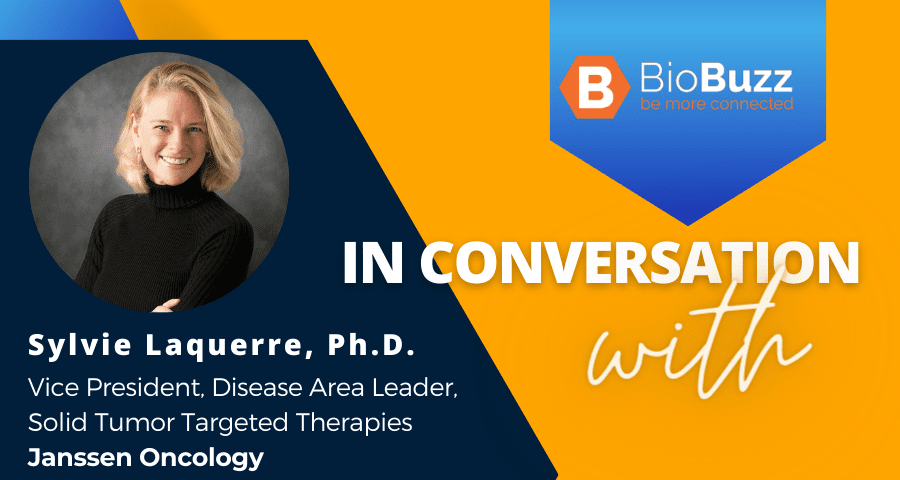
In Conversation With Sylvie Laquerre, Ph.D., Janssen Oncology
By Sam Hopkins | October 2, 2023
| BioBuzz has been connecting the life science workforce since 2009. We’ve built an expansive community in the Mid-Atlantic with a national readership that spans from Massachusettes to Florida, and New York to California. For our next chapter, we’re building a proprietary talent logistics model to help employers source and hire life science talent. Learn more. |
Sylvie Laquerre, Ph.D., is Vice President of the Solid Tumor Targeted Therapy Disease Area for Janssen Research & Development, LLC, one of the Janssen Pharmaceutical Companies of Johnson & Johnson. She will be at JLABS @ Washington, DC on Wednesday, October 25 to speak and educate the audience at the event, “Harnessing the Potential of Antibody Drug Conjugates in Oncology.”
We connected with Dr. Laquerre recently to help us understand the role of ADCs in cancer care, regional strengths in science and development, and regulatory considerations and education needed in the Capital area to ensure progress continues in the field.
Some have dubbed Antibody Drug Conjugates (ADCs) ‘the next pillar of cancer therapeutics.” Is that deserved? Why or why not?
Like any technology, there is no answer to all cancers, but many novel platforms will eventually serve a defined patient population. Several decades ago, we saw gene therapy as most promising for several diseases, but today, we have learned about some of its limitations while identifying diseases greatly benefiting from this technology. It is the same for RNA-based technology, CD3 redirection, CAR-T and most likely ADCs. ADCs had a particularly difficult start. Many were tested clinically, which led to an early first approval, but decades lapsed until the second wave of approvals emerged. Between the first and second wave, the technology has improved, but we are still struggling to fully understand ADCs’ full mechanism of action.
Considering the growing interest in ADCs as a promising class of therapeutics, how should regulatory agencies balance the need for innovation and patient access with the imperative to ensure safety and efficacy in the development and approval process of ADCs?
Regulatory agencies are applying the same rigor for ADCs as for other modalities or agents. The agents must be safe, meaning dosed at an initial safe dose, then proceeding through dose escalation where safety and efficacy criteria are taken into consideration to define the dose, at which time more patients will be studied. ADCs have been placed on FastTrack or Breakthrough designation, providing a path for potential faster approval.
What should be prioritized to propel ADC development and innovation in the field?
ADCs are a complex technology–many refer to them as three drugs in one: 1) a cancer selective monoclonal antibody, 2) a toxic payload, and 3) a linker attaching the payload to the antibody. Every part of an ADC plays an important role. The cancer selectivity of the antibody is very important and perhaps the part where the least progress has been made. To improve cancer selectivity, efforts are being made to branch from monoclonal antibodies to biparatopic or bispecific antibodies. This increased antibody complexity may lead to overall reduced pharmacological properties of the antibody.
However, in the past decade, researchers have optimized the linkers for increased stability and pharmacokinetic properties. Some linkers are cleavable by cellular or tumor microenvironment rich enzymes, others are uncleavable to avoid potential toxicity from the released payload.
Important progress has been made on payload technology, where potency and bystander capability have been tuned to reach the desired effect. Importantly, we also improved the conjugation technology of the linker to the antibody. As an ADC is designed, all these factors need to be taken into consideration. To make the situation even more challenging, the testing of ADCs is not trivial. For better clinical prediction, ADCs need to be tested in animal models, often requiring higher species to fully assess their safety profile.
I believe that all of these technological improvements were required, but some were needed to compensate for the limitation in cancer selectivity of the chosen targets. A target that is not uniformly expressed will require ADC with bystander effect payload (to kill cancer cells not expressing the target), and a target that is expressed in normal tissues will require an ADC with a weaker payload (to reduce killing of normal cells with target, hopefully lower than cancer, expression) and most likely higher drug-antibody-ratio (DAR). However, the bystander effect and high DAR will also lead to more toxicity and often lower than optimal ADC pharmaco-properties.
What could propel greater investment into ADC innovation?
ADCs are expensive to produce. As noted, they are three drugs in one, and the payload reagent is toxic, requiring special containment, which significantly increases the manufacturing cost. Overall, I believe researchers need to find better “cancer specific targets” and determine how to lower the cost of goods to manufacture ADCs. ADCs are extending life but are not curing most patients. Combinations of drugs have shown higher probability of success, especially in combination with immunotherapy drugs. Today, most ADCs are too toxic to be combined with immunotherapy drugs, so decreasing ADC toxicity to permit combination therapy could potentially lead to a cure, and thus propel additional investment.
You’re coming to DC to speak at the program, “Harnessing the Potential of Antibody Drug Conjugates (ADCs) in Oncology,” on Oct. 25 at Johnson & Johnson Innovation – JLABS @ Washington, DC. Can you talk about the potential that the Capital Region holds in driving innovation in oncology?
Since JLABS @ Washington DC is near the NIH, where fundamental researchers reside with access to important collections of human tissues and novel technologies, it may provide the ecosystem to identify better cancer specific targets.
What areas of the US or the world are leading in ADC research and commercial development?
The US is leading the number of approved and under clinical testing ADCs, followed very closely by China. ADC technology is advancing rapidly in China and so are their manufacturing capabilities. Also, with the initial linker-payload technology reaching the end of patent protection, we will most likely see a surge of ADCs with older technology entering the market, but hopefully using improved cancer selective targets.
Are there examples of specific successes to date at Janssen that show how you are blazing the trail for efficient advancement of high-impact ADCs?
At Janssen, we are working on all aspects to improve ADCs. We have an internal engine to identify new cancer specific targets, we have solid and proven capability in developing industry best-in-class antibodies, we collaborate with state-of-the-art companies with unique linker-payload technologies and we apply the rigor required for successful R&D., In my opinion, there is no one secret recipe, however, Janssen’s willingness to learn from ours and others’ failures, our steadfast pursuit of innovation, combined with hard work and dedication keep us focused on the singular goal of humbly fighting cancer and one day hopefully eliminating the disease.
Join Dr. Laquerre and other oncology experts at the half-day symposium, Harnessing the Potential of Antibody Drug Conjugates (ADCs) in Oncology, on October 25 at Johnson & Johnson Innovation – JLABS @ Washington, DC. Register here.
After the program concludes, there will be an opportunity to participate in partnering meetings to connect one-on-one with industry leaders in this space. All individuals (startups, oncology companies, academics and researchers, and industry partners) interested in an opportunity for a one-on-one partnering meeting must apply by this Friday, October 6. Register for the event to receive a link to the application.
- About the Author
- Latest Posts
Sam Hopkins has spent the past decade in the Baltimore area life-science and healthcare ecosystem, including roles at Johns Hopkins, the University of Maryland, the U.S. Army, and early-stage companies. He spent the previous decade as a journalist, which saw him cover everything from clean energy conferences in Morocco, to Soviet-era Estonian rock’n’roll, to trailblazing CEOs in Timonium. Sam is an avid athlete and coach, and he lives with his wife and two sons in Baltimore’s Oakenshawe neighborhood. You can often find him around town spinning records as DJ Balagan, or performing in musical groups Sink and South of Boundary.








